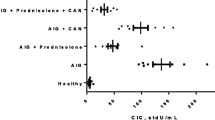Abstract
Leflunomide (HWA 486, a novel isoxazol derivative), shown to have potent immunosuppressant and antiinflammatory effects, was evaluated for its inhibitory and therapeutic effects on the glomerulonephritis induced in rats by rabbit antiserum against rat glomerular basement membrane. Leflunomide was administered orally to rats at 0.5 and 2 mg/kg/day for 20 days from 2 days before injection of the rabbit antiserum and at 2 mg/kg/day for 14 days from 5 days after the antibody injection. The present study consisting of 2 experiments for inhibitory (I) and therapeutic (II) effects of leflunomide revealed the following effects at 2 mg/kg: in experiment I, significant decreases in (a) urinary total protein, (b) plasma total cholesterol and fibrinogen and (c) thymus weight, and decreased incidences of fibrin deposits in Bowman's space, adhesion of the glomerulus to Bowman's capsule and deposition of rat IgG and C3; and in experiment II, decreases in (a), (b) and (c), though smaller than in experiment I, and decreases deposition of rat C3. Thus, leflunomide had potent inhibitory and limited therapeutic effects on glomerulonephritis, suggesting that the compound is effective in inhibiting the onset and development of glomerulonephritis.
Similar content being viewed by others

References
R. T. McCluskey,Immunologic mechanisms in glomerular diseases. InPathology of the kidney (3rd edition), (ed. R. H. Heptinstall) pp. 301–385. Little Brown, Boston 1983.
E. N. Wardle,Cells and mediators in glomerulonephritis. Nephron49, 265–276 (1988).
T. Takemura, K. Yoshioka, N. Akano, H. Miyamoto, K. Matsumoto and S. Maki,Glomerular deposition of crosslinked fibrin in human kidney diseases. Kidney Int.32, 102–111 (1987).
M. Ito, H. Yamada, K. Okamoto and Y. Suzuki,Crescentic type nephritis induced by anti-glomerular basement membrane (GMB) serum in rats. Jap. J. Pharmacol.33, 1140–1154 (1983).
T. Ogawa, M. Inazu, M. Omosu and S. Hayashi,Effect of antithrombin III on glomerulonephritis induced by antibasement membrane antibody in rats. Jap. J. Nephrol.32, 261–266 (1990).
M. Ito, T. Nagamatsu and Y. Suzuki,Pharmacological study of experimental rat glomerulonephritis (10): Changes in coagulation and fibrinolysis systems in nephritis induced by anti-GBM antibody. Jap. J. Nephrol.23, 297–307 (1981).
G. H. Thoenes, K. H. Langer, R. R. Bartlett and R. Schleyerbach, InImmunointervention in autoimmune diseases. Abstract Book, Workshop 24, Paris 1988.
S. Popovic and R. R. Bartlett,Disease modifying activity of HWA 486 on the development of SLE in MRL/1-mice. Agents and Actions19, 313–314 (1986).
R. R. Bartlett,Immunopharmacological profile of HWA 486, a novel isoxazol derivative. II. In vivo immunomodulating effects differ from those of cyclophosphamide, prednisolone or cyclosporin A. Int. J. Immunopharmac.8, 199–204 (1986).
Author information
Authors and Affiliations
Rights and permissions
About this article
Cite this article
Ogawa, T., Inazu, M., Gotoh, K. et al. Effects of leflunomide on glomerulonephritis induced by antibasement membrane antibody in rats. Agents and Actions 31, 321–328 (1990). https://doi.org/10.1007/BF01997627
Issue Date:
DOI: https://doi.org/10.1007/BF01997627



